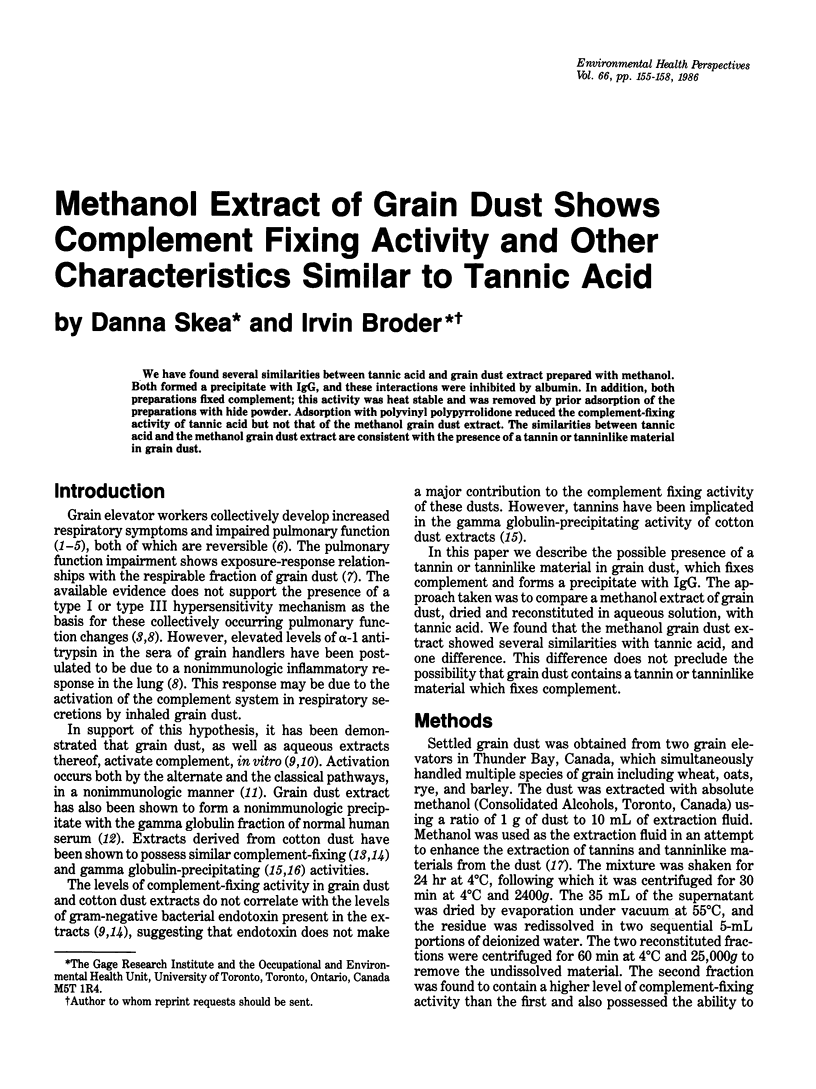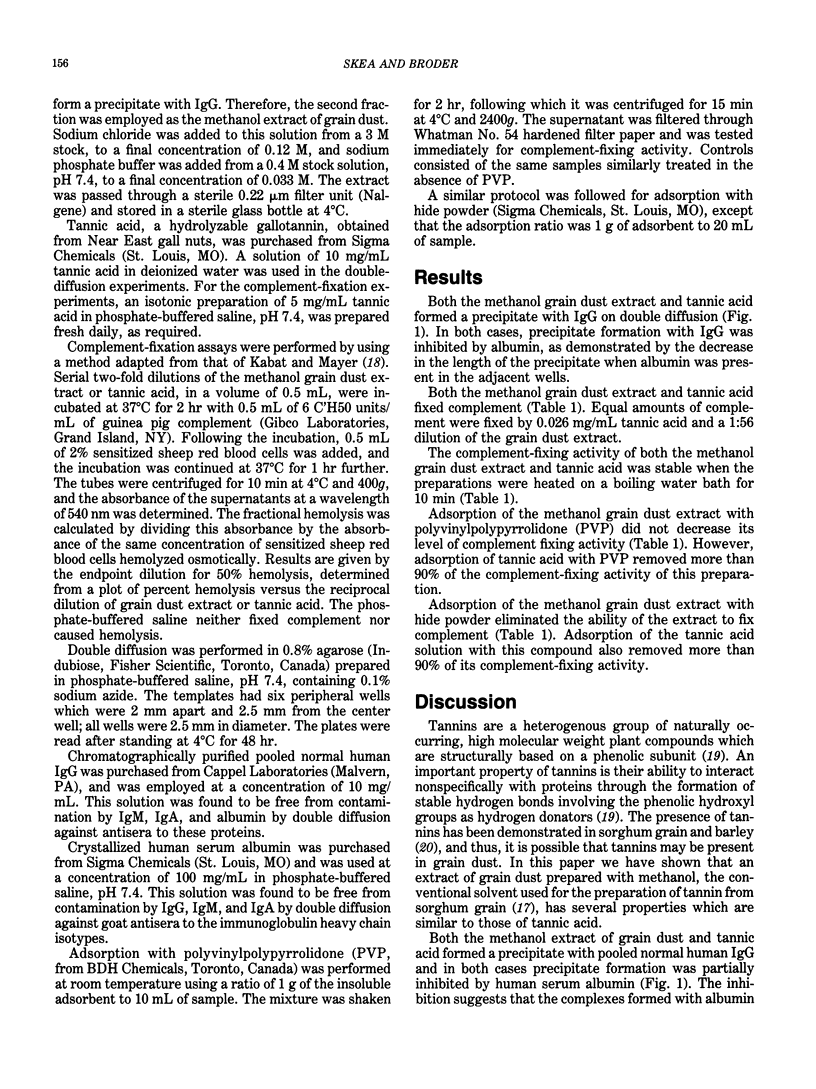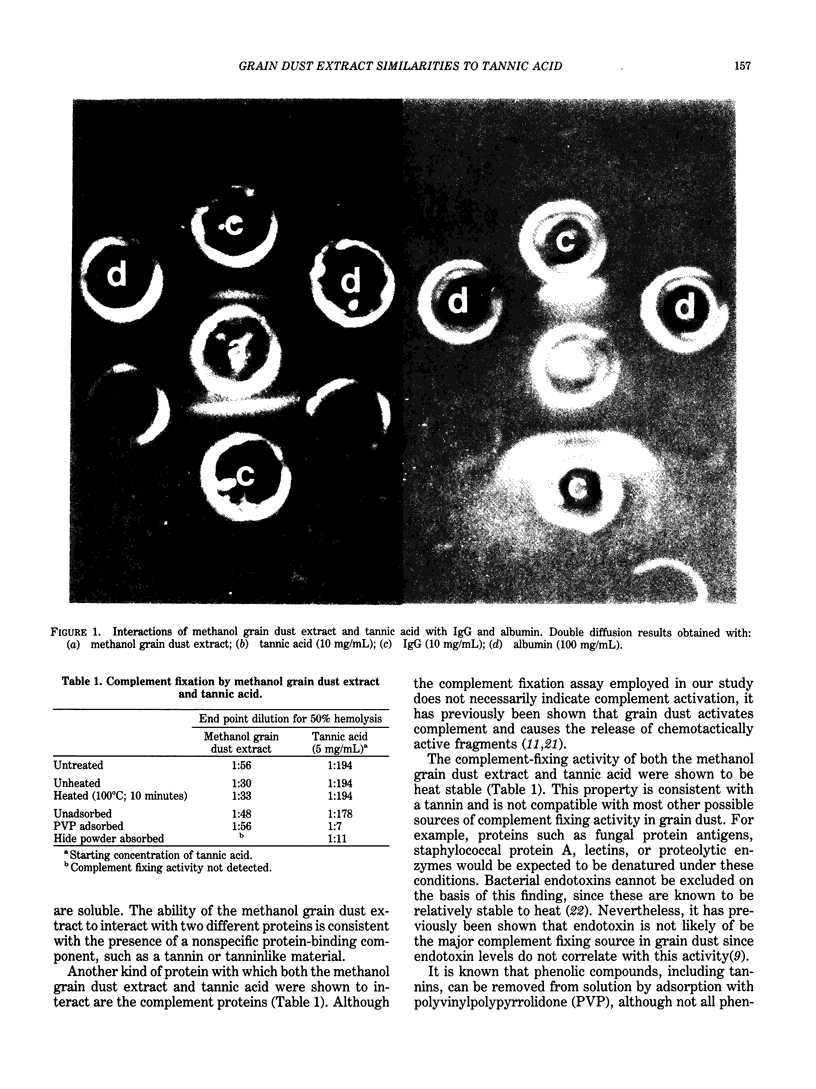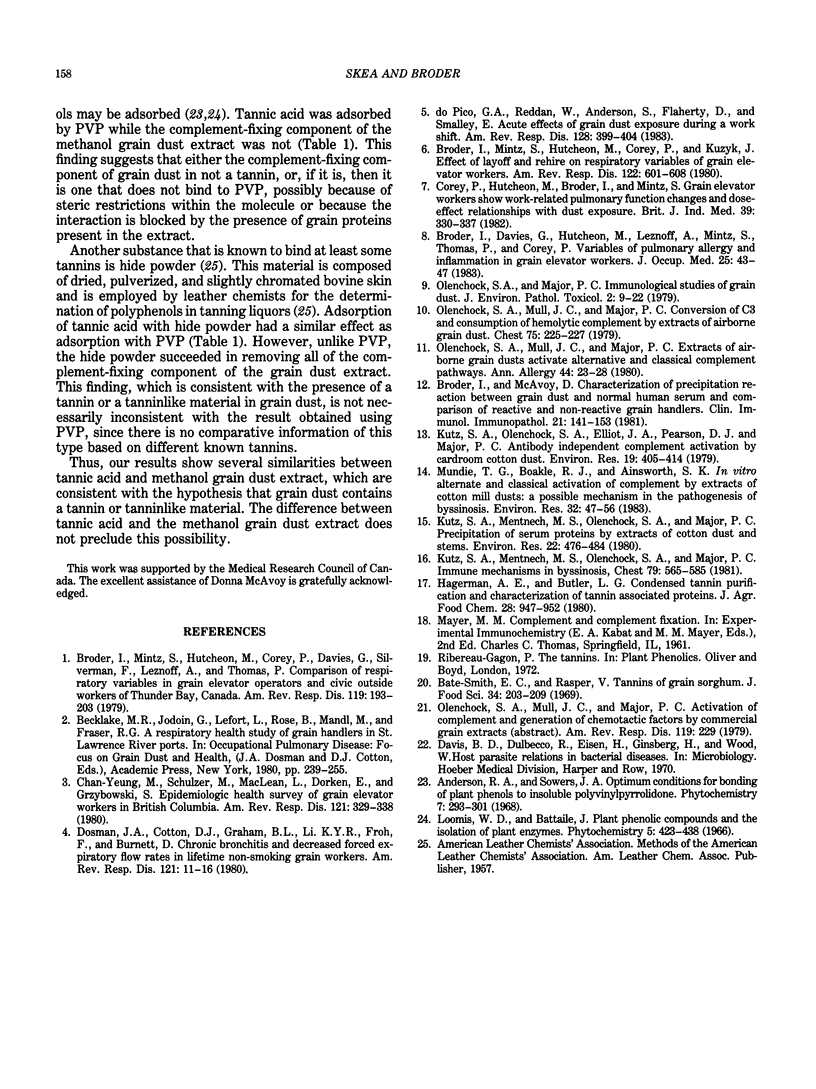Abstract
We have found several similarities between tannic acid and grain dust extract prepared with methanol. Both formed a precipitate with IgG, and these interactions were inhibited by albumin. In addition, both preparations fixed complement; this activity was heat stable and was removed by prior adsorption of the preparations with hide powder. Adsorption with polyvinyl polypyrrolidone reduced the complement-fixing activity of tannic acid but not that of the methanol grain dust extract. The similarities between tannic acid and the methanol grain dust extract are consistent with the presence of a tannin or tanninlike material in grain dust.
Full text
PDF



Images in this article
Selected References
These references are in PubMed. This may not be the complete list of references from this article.
- Broder I., Davies G., Hutcheon M., Leznoff A., Mintz S., Thomas P., Corey P. Variables of pulmonary allergy and inflammation in grain elevator workers. J Occup Med. 1983 Jan;25(1):43–47. doi: 10.1097/00043764-198301000-00014. [DOI] [PubMed] [Google Scholar]
- Broder I., McAvoy D. Characterization of precipitation reaction between grain dust and normal human serum and comparison of reactive and nonreactive grain handlers. Clin Immunol Immunopathol. 1981 Nov;21(2):141–153. doi: 10.1016/0090-1229(81)90203-8. [DOI] [PubMed] [Google Scholar]
- Broder I., Mintz S., Hutcheon M. A., Corey P. N., Kuzyk J. Effect of layoff and rehire on respiratory variables of grain elevator workers. Am Rev Respir Dis. 1980 Oct;122(4):601–608. doi: 10.1164/arrd.1980.122.4.601. [DOI] [PubMed] [Google Scholar]
- Broder I., Mintz S., Hutcheon M., Corey P., Silverman F., Davies G., Leznoff A., Peress L., Thomas P. Comparison of respiratory variables in grain elevator workers and civic outside workers of Thunder Bay, Canada. Am Rev Respir Dis. 1979 Feb;119(2):193–203. doi: 10.1164/arrd.1979.119.2.193. [DOI] [PubMed] [Google Scholar]
- Chan-Yeung M., Schulzer M., MacLean L., Dorken E., Grzybowski S. Epidemiologic health survey of grain elevator workers in British Columbia. Am Rev Respir Dis. 1980 Feb;121(2):329–338. doi: 10.1164/arrd.1980.121.2.329. [DOI] [PubMed] [Google Scholar]
- Corey P., Hutcheon M., Broder I., Mintz S. Grain elevator workers show work-related pulmonary function changes and dose-effect relationships with dust exposure. Br J Ind Med. 1982 Nov;39(4):330–337. doi: 10.1136/oem.39.4.330. [DOI] [PMC free article] [PubMed] [Google Scholar]
- Dosman J. A., Cotton D. J., Graham B. L., Li K. Y., Froh F., Barnett G. D. Chronic bronchitis and decreased forced expiratory flow rates in lifetime nonsmoking grain workers. Am Rev Respir Dis. 1980 Jan;121(1):11–16. doi: 10.1164/arrd.1980.121.1.11. [DOI] [PubMed] [Google Scholar]
- Hagerman A. E., Butler L. G. Condensed tannin purification and characterization of tannin-associated proteins. J Agric Food Chem. 1980 Sep-Oct;28(5):947–952. doi: 10.1021/jf60231a011. [DOI] [PubMed] [Google Scholar]
- Kutz S. A., Mentnech M. S., Olenchock S. A., Major P. C. Precipitation of serum proteins by extracts of cotton dust and stems. Identification of beta-lipoprotein and production of specific antibodies. Environ Res. 1980 Aug;22(2):476–484. doi: 10.1016/0013-9351(80)90159-0. [DOI] [PubMed] [Google Scholar]
- Kutz S. A., Olenchock S. A., Elliott J. A., Pearson D. J., Major P. C. Antibody-independent complement activation by cardroom cotton dust. Environ Res. 1979 Aug;19(2):405–414. doi: 10.1016/0013-9351(79)90065-3. [DOI] [PubMed] [Google Scholar]
- Miller R. D., Gleich G. J., Offord K. P., Dunnette S. L. Immunoglobulin concentrations in serum and nasal secretions in chronic obstructive pulmonary disease. A matched-pair study. Am Rev Respir Dis. 1979 Feb;119(2):229–238. doi: 10.1164/arrd.1979.119.2.229. [DOI] [PubMed] [Google Scholar]
- Mundie T. G., Boackle R. J., Ainsworth S. K. In vitro alternative and classical activation of complement by extracts of cotton mill dust: a possible mechanism in the pathogenesis of byssinosis. Environ Res. 1983 Oct;32(1):47–56. doi: 10.1016/0013-9351(83)90190-1. [DOI] [PubMed] [Google Scholar]
- Olenchock S. A., Major P. C. Immunological studies of grain dust. J Environ Pathol Toxicol. 1979 May-Jun;2(5):9–22. [PubMed] [Google Scholar]
- Olenchock S. A., Mull J. C., Major P. C. Conversion of C3 and consumption of hemolytic complement by extracts of airborne grain dust. Chest. 1979 Feb;75(2 Suppl):225–227. [PubMed] [Google Scholar]
- Olenchock S. A., Mull J. C., Major P. C. Extracts of airborne grain dusts activate alternative and classical complement pathways. Ann Allergy. 1980 Jan;44(1):23–28. [PubMed] [Google Scholar]
- doPico G. A., Reddan W., Anderson S., Flaherty D., Smalley E. Acute effects of grain dust exposure during a work shift. Am Rev Respir Dis. 1983 Sep;128(3):399–404. doi: 10.1164/arrd.1983.128.3.399. [DOI] [PubMed] [Google Scholar]



